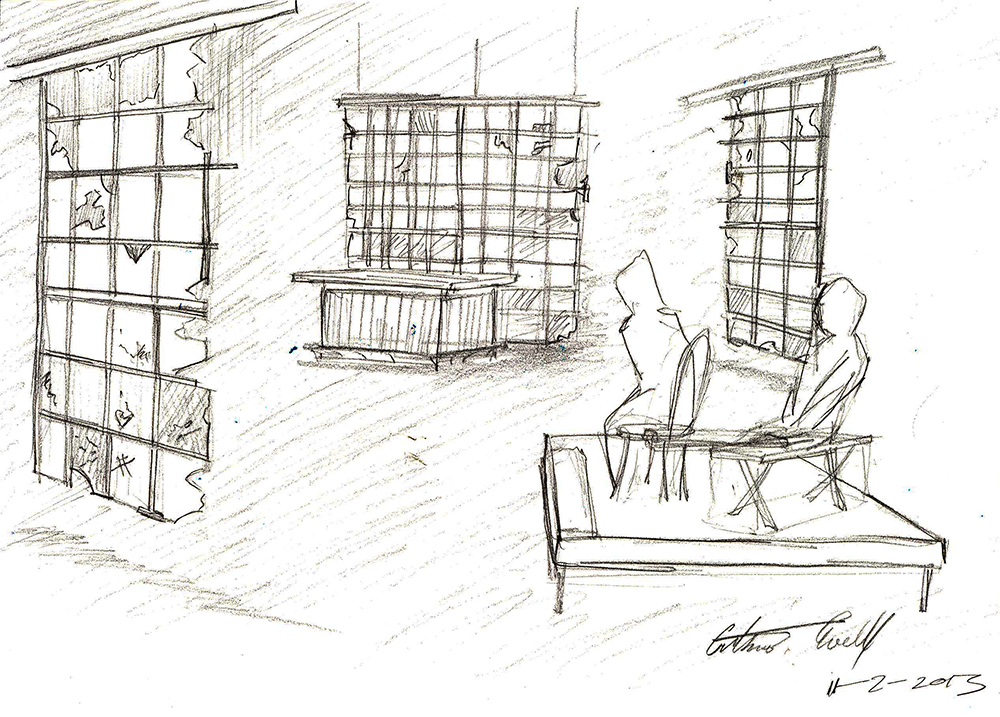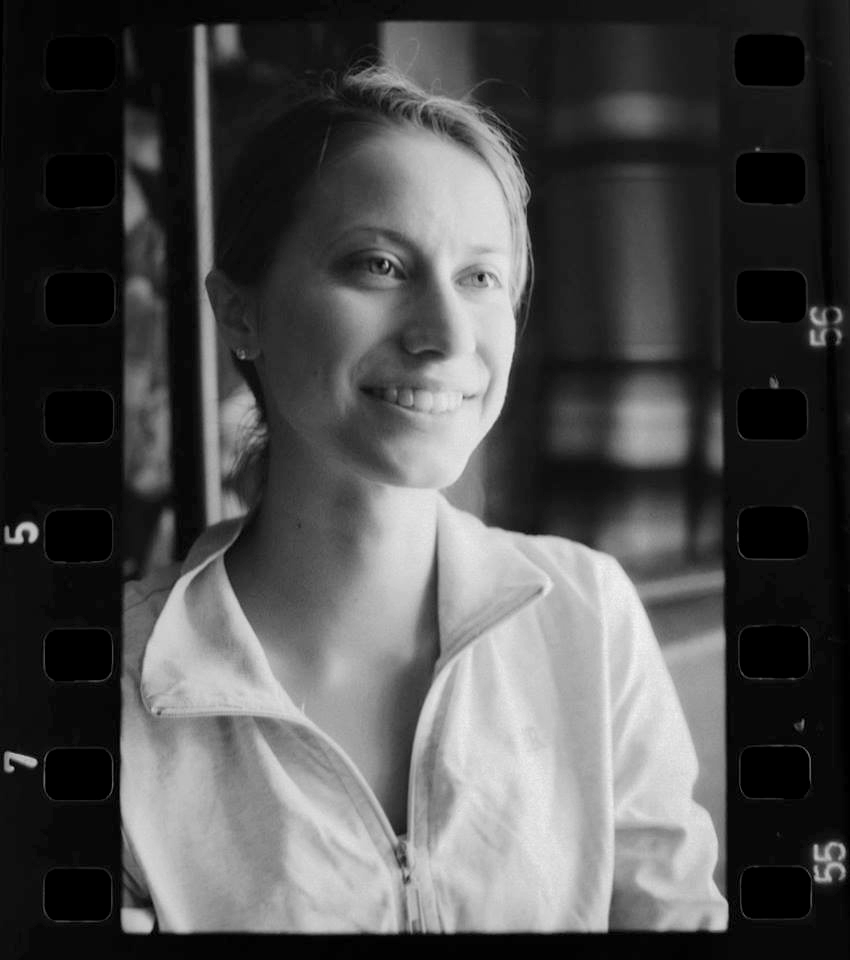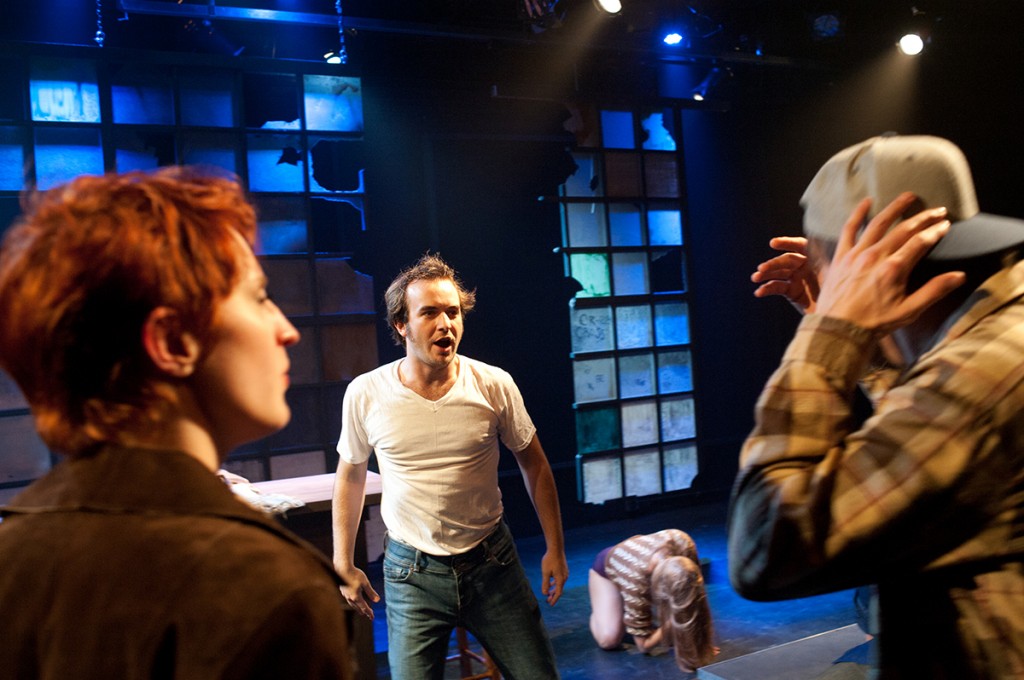The following is a conversation between Kathryn Stewart, Book-It’s 2013-14 Artistic Intern and Catherine Cornell, a scenic and properties designer who most recently designed for Book-It’s Jesus’ Son.
Kathryn: So, I’m noticing your sketchbook and I’m so curious that I have to ask: What do you put in there? How is it organized?
Catherine: I take this everywhere with me. I think there are about five shows of work in here. I’m usually working on a few shows at the same time, and the sketches are all mixed together. I use a ruler to mark the important pages. And I can just remember, when I flip through it, “Oh, right, that sketch goes with that show!”

K: When did you officially decide to go into set design?
C: When I was in college, I didn’t know what I wanted to do but I thought I wanted to study architecture. I started taking the prerequisites, and decided I really didn’t like it. It wasn’t right for my style, or the way I like to work. It was my mom who actually suggested that I look into scenery for theatre, since I had taken acting classes in high school and enjoyed them. I didn’t believe it was a real thing! I went to the University of Michigan film school first, and they directed me to the theatre school. It was a match made in heaven. I looked at their course offerings, and it was everything I wanted to do.
K: That’s how I feel when I look at some grad school programs for directing. It’s exactly how I want to spend my time.
C: Yes, you read it and you say, “Of course I want to study costume design!”
K: What kind of projects did you work on in college?
C: Mostly the school projects that were assigned to me, but also some student run things. Some students had these basement-run programs, with no funding and super cheap budgets. They’d have about $100 dollars for set and props. And not a lot of support from the [scene] shop; the shops didn’t like loaning to them because stuff might never come back. Sometimes… we’d have to scrounge through the trash.
However, I did work with this student group called MUSKET. It was an official student organization, and was supported by both the theatre department and the university at large. They did two shows a year, performed in the largest venue on campus, and had thousands of dollars to use. I did Cabaret with them, and I had a budget of about $4,000 dollars. It was really cool because we were students and we had student lives to balance, and were not fully experienced, but we had thousands of dollars to play around with.
My culminating project was working on Cloud 9 for the main stage, working with a guest director. It was great to work with someone who had no preconceived notions about the students at the university, who treated me like a professional director would treat a professional set designer.
K: So why did you choose Seattle?
C: I actually followed my boyfriend, who got a job at Microsoft. At the time, I was convinced I’d move to L.A. I came out here with one small carry-on that had two weeks worth of clothes to help him move. Then I went to L.A …I was there one week and I already knew I hated it. So I came back here, for four months (with two weeks worth of stuff, remember) until I went back to Michigan, picked up the rest of my things to bring to Seattle. And I’ve been here ever since.
K: It was meant to be! How did you start working as a set designer?
C: I basically sent emails to all the production managers whose contact information I could find. I knew a few people, such as a prop person at Seattle Rep who gave me a tour and looked over my portfolio. The way I met Anders, who was Book-It’s production manager at the time, was through email. He agreed to meet me and look over my work. Months later, I got a call asking me to be a props artisan. That’s how I started. By that time, I’d developed a core group of friends who work in the theatre, and there is a lot of opportunity to meet people and network.

K: Now I hope you don’t mind this next question, but personally, one thing I’ve found this past year is that when people I work with find out my age, there is generally a reaction. You are on the young side to be working as regularly and successfully as you are: Does your age ever get mentioned?
C: Sometimes I wonder if they know I’m as young as I am. I mean some people (generally older people) think I’m a teenager! I look young. Sometimes I feel like an imposter, sneaking around in a business that I’m too young for. Then I remember: This is the business I want to be in. And I don’t tend to be someone who brags about herself, but I believe I’m good enough to be on the level that I am. Age, to some people, says something about experience. My goal is to 1) Gain more experience and 2) Prove that I have a lot of experience already.
K: So can you describe your design process for me?
C: I will usually read the script (or the book) first, and circle words that stick out to me, that give me visuals in my mind. And this book and script for Jesus’ Son has TONS of imagery. My favorite is this scene where he’s describing a woman’s scream in terms of light, as “incinerating diamonds” and a “slab of light” coming out from under the door. So, I’d read something like that and circle it. The book also had a lot of references to color, greens and blues, and I’d mark things like that. I like to have time to sit on it, and reread the marks and circles. Then I begin my image research. I find hundreds of images, not concrete, but more like images that have the feel or environment that I envision. In Jesus’ Son, there was the bar with green, and the idea of light and refraction. I want to sense what this world feels like.
I then think about what spaces we need to have and create. I always make a production breakdown, with every scene and location, and the scenery and props needed, plus other notes like mood, and time of day. Figuring out practically what we actually need on stage.
[vine url=”https://vine.co/v/hj77vJj1HZt” width=”300″ height=”300″]
The scenic model for Jesus’ Son
K: What element, in the script or set, are you most excited for with the set design for Jesus’ Son?
C: I’m most excited to see how everything is going to come together. There is always a meeting of the various technical elements. Especially with set and lights. They are separate things, designed by separate people, but they are so dependent on each other. For example, I’m interested in seeing how my set interacts with the lights. However, how the lights look depends on the windows I designed, and Kent [Cubbage, lighting designer] is using my scenery to help transform his lights. They’re both playing off of each other. They both enhance each other. I’m excited to see how each makes the other better.

Jesus’ Son plays from November 5 to November 24. Purchase tickets here.